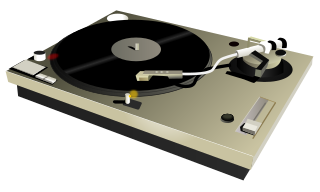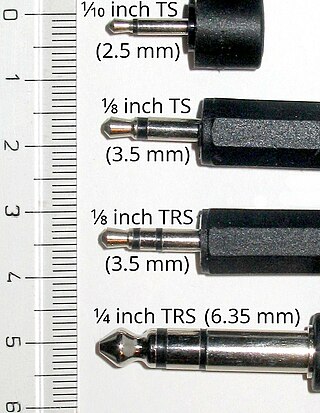
A phonograph, later called a gramophone, and since the 1940s a record player, or more recently a turntable, is a device for the mechanical and analogue reproduction of sound. The sound vibration waveforms are recorded as corresponding physical deviations of a helical or spiral groove engraved, etched, incised, or impressed into the surface of a rotating cylinder or disc, called a record. To recreate the sound, the surface is similarly rotated while a playback stylus traces the groove and is therefore vibrated by it, faintly reproducing the recorded sound. In early acoustic phonographs, the stylus vibrated a diaphragm that produced sound waves coupled to the open air through a flaring horn, or directly to the listener's ears through stethoscope-type earphones.

A phone connector is a family of cylindrically-shaped electrical connectors primarily for analog audio signals. Invented in the late 19th century for telephone switchboards, the phone connector remains in use for interfacing wired audio equipment, such as headphones, speakers, microphones, mixing consoles, and electronic musical instruments. A male connector, is mated into a female connector, though other terminology is used.

A magnetic cartridge, more commonly called a phonograph cartridge or phono cartridge or (colloquially) a pickup, is an electromechanical transducer that is used to play phonograph records on a turntable.
PS Audio is an American company specializing in high-fidelity audio components equipment for audiophiles and the sound recording industry. It currently produces audio amplifiers, preamplifiers, power related products, digital-to-analog converters, streaming audio, music management software and cables.
Shure Inc. is an audio products corporation headquartered in the USA. It was founded by Sidney N. Shure in Chicago, Illinois, in 1925 as a supplier of radio parts kits. The company became a consumer and professional audio-electronics manufacturer of microphones, wireless microphone systems, phonograph cartridges, discussion systems, mixers, and digital signal processing. The company also manufactures listening products, including headphones, high-end earphones, and personal monitor systems.
Bang & Olufsen (B&O) is a Danish high-end consumer electronics company that designs and manufactures audio products, television sets, and telephones, originally from Denmark, founded in 1925 by Peter Bang and Svend Olufsen, who designed a radio to work with alternating current, a product of significance at a time when most radios were still running on batteries.

McIntosh Laboratory is an American manufacturer of handcrafted high-end audio equipment headquartered in Binghamton, New York. It is a subsidiary of McIntosh Group, which in November 2024 was acquired by Bose Corporation, a fellow American audio company..
Denon is a Japanese electronics company dealing with audio equipment. The Denon brand came from a merger of Denki Onkyo and others in 1939, but it originally started as Nippon Chikuonki Shoukai in 1910 by Frederick Whitney Horn, an American entrepreneur.
Roksan is a British manufacturer of high fidelity audio products for domestic use, based in Rayleigh, Essex. It is best known for its influential and innovative design for hi-fi equipment, and in particular its Xerxes platform for playing LP records.

Audio-Technica Corporation is a Japanese company that designs and manufactures professional microphones, headphones, turntables, phonographic magnetic cartridges, and other audio equipment.
Musical Fidelity is a British producer of high-end audio equipment focusing on streaming music players, and its core product range of amplifiers of various types. Other products have included headphones, Digital-Analog Converters (DACs), CD players, Bluetooth Receivers, ‘all-in-one systems’. Founded in the United Kingdom in 1982, they are known for their unusual industrial design, Nuvistor tube use and Class-AB amplifiers.

Stax Ltd. is a Japanese company that makes high-end-audio equipment. Stax is best known for their electrostatic and electret headphones, which they call “earspeakers.” Electrostatic headphones work similarly to electrostatic loudspeakers, but on a smaller scale. In December 2011, Chinese audio equipment company Edifier announced that it had acquired 100% equity in Stax.
Stanton Magnetics, doing business as Stanton, is a business unit of inMusic Brands that designs and markets turntables, cartridges, DJ mixers, DJ media players, and DJ controllers.

SRS Labs, Inc. was a Santa Ana, California-based audio technology engineering company that specialized in audio enhancement solutions for wide variety of consumer electronic devices. Originally a part of Hughes Aircraft Company, the audio division developed the Sound Retrieval System technology, and in 1993 was separated off to form SRS Labs, Inc. In 1996 SRS Labs became a publicly traded company on Nasdaq, SRSL.

Pro-Ject Audio Systems is a manufacturer of audiophile equipment, founded in 1991 by Heinz Lichtenegger and located in Mistelbach, Austria. Pro-Ject Audio Systems designs the products in Austria and produces them in plants located in Germany, Czech Republic and Slovakia.

The Roksan Xerxes transcription turntable is a record player named after the Persian king Xerxes I and produced by London-based Roksan Audio. Designed by Roksan co-founder, Touraj Moghaddam, the Xerxes is a belt-driven turntable with a solid plinth. Launched in 1985, the sound quality of the product positioned it as a strong competitor against the established industry leader, the Linn Sondek LP12. Many reviewers use the Xerxes as a reference turntable.

The NAD 3020 is a stereo integrated amplifier by NAD Electronics, considered to be one of the most important components in the history of high fidelity audio. Launched in 1978, this highly affordable product delivered a good quality sound, which acquired a reputation as an audiophile amplifier of exceptional value. By 1998, the NAD 3020 had become the most well known and best-selling audio amplifier in history.

Compatible Discrete 4, also known as Quadradisc or CD-4 was a discrete four-channel quadraphonic system for phonograph records. The system was created by JVC and RCA in 1971 and introduced in May 1972. Hundreds of recordings using this technology were released on LP during the 1970s.

Manley Laboratories, Inc. is an American manufacturer of pro audio and high-end audio equipment located in Chino, California.
U-Turn Audio is an American audio equipment manufacturer located in Woburn, Massachusetts. The company was established in 2012 by Benjamin Carter, Robert Hertig, and Peter Maltzan. Its primary products are turntables, phono preamps, and loudspeakers.














